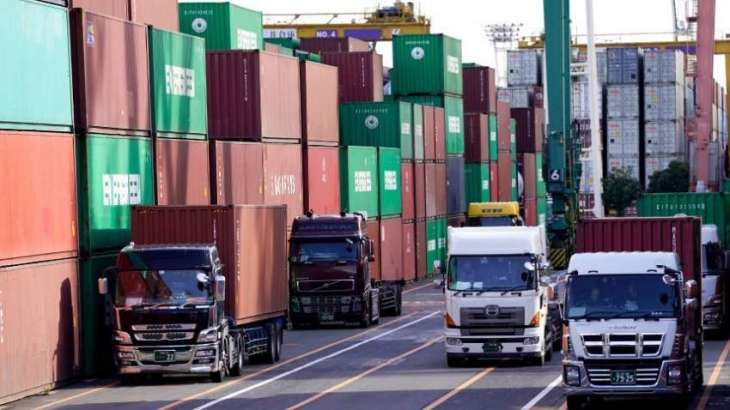The Commonwealth of Independent States (CIS) Agreement on the Creation of a Free Trade Zone (FTZ) was signed by the presidents of Azerbaijan, Armenia, Belarus, Georgia, Kazakhstan, Kyrgyzstan, Moldova, Russia, Tajikistan, Turkmenistan, Uzbekistan and Ukraine at a meeting of the CIS Council at the level of heads of state in Moscow on April 15, 1994
MOSCOW (Pakistan Point News / Sputnik - 16th April, 2019) The Commonwealth of Independent States (CIS) Agreement on the Creation of a Free Trade Zone (FTZ) was signed by the presidents of Azerbaijan, Armenia, Belarus, Georgia, Kazakhstan, Kyrgyzstan, Moldova, Russia, Tajikistan, Turkmenistan, Uzbekistan and Ukraine at a meeting of the CIS Council at the level of heads of state in Moscow on April 15, 1994.
It implied that duty-free trade would be carried out in the FTZ, tariff and non-tariff restrictions in mutual trade would be lifted, and thus numerous trade barriers would be removed. All of this was supposed to increase turnover and create preconditions for sustainable economic growth of the CIS member states.
But the parties to the agreement failed to develop and multilaterally agree upon a general list of exceptions to free trade regime, provided for by the document.
Therefore, on April 2, 1999, the presidents of Azerbaijan, Armenia, Belarus, Georgia, Kazakhstan, Kyrgyzstan, Moldova, Russia, Tajikistan, Uzbekistan and Ukraine met in Moscow to sign the Protocol on Amending and Supplementing the Agreement on the Creation of a Free Trade Area, which needed to be adapted to legislation of each state. Turkmenistan did not sign the document.
According to the protocol, exceptions to free trade regime were temporary and could be applied on the basis of bilateral documents, meaning that a multilateral free trade regime was introduced.
The document prescribed gradual cancellation of customs duties, taxes and fees, which have equivalent effect and quantitative restrictions in mutual trade; elimination of other barriers to a free transfer of goods and services; creation and development of an effective system of mutual settlement of disputes among other things.
The agreement, its protocol and a set of other documents, which developed the legal framework on this subject, created an effective tool for the consistent establishment of a free trade regime. At the same time, the agreement contained many exceptions, the list of goods and activities that were not covered by the document.
The parties to the agreement were entitled to introduce any measures of state regulation that it considered necessary in a large number of cases, such as "protection of industrial and intellectual property," "preservation of exhaustible natural resources," or in case of the "violation of balance-of-payments," and other things.
This meant that the parties to the agreement had the right to impose any duties on the export of natural resources, and in addition, impose import duties on goods from other CIS countries.
Too many exceptions made the document "unworkable." Therefore, the multilateral free trade regime has not been fully formed. A number of CIS member states did not ratify both documents, the FTZ Agreement and its Protocol, which practically slowed down the implementation of a large-scale free trade zone.
The free trade regime, which was embodied in bilateral free trade agreements, continued to exist between the Commonwealth partners.
The replacement of one multilateral document with hundreds of others created inconveniences and resulted in discriminatory impact on trade. Under the conditions of the objective imbalance in mutual trade between the CIS member states, there was an urgent need to complete the introduction of a free trade zone in full-scale regime.
In November 2008, the CIS heads of government approved the CIS Economic Development Strategy for the period until 2020. The completion of the formation and operation of a free trade zone within the CIS in accordance with the rules and regulations of the World Trade Organization (WTO); laying of the foundations for creating a common economic space; development of common markets for certain types of products, primarily agricultural products; creation of effective mechanisms for monetary and financial cooperation were listed as priorities in the adopted strategy.
Intensive work to draft a new document on the free trade zone began in 2009. Its development lasted for almost 10 years before that. As a result of long, pressing, but meaningful negotiations, all the participants agreed on the document.
The new CIS Free Trade Area agreement (CISFTA) was signed on October 18, 2011.
The document was signed by the heads of government of eight CIS member states: Armenia, Belarus, Kazakhstan, Kyrgyzstan, Moldova, Russia, Tajikistan and Ukraine, which accounted for over 90 percent of the CIS mutual trade.
It was planned to continue consultations and negotiations on accession to the treaty of Azerbaijan, Uzbekistan and Turkmenistan, while Georgia officially withdrew from the CIS in August 2009.
The treaty replaced a number of multilateral and about 100 bilateral documents that previously regulated free trade in the CIS countries. According to the document, the number of exceptions was significantly reduced. The parties agreed to freeze export duties at the existing level and, six months after the treaty entered into force, to begin negotiations on their phasing-out. They also agreed to negotiate freedom of transit, and grant to each other a national regime for internal taxes, fees, rules relating to the sale, transportation, distribution, use, processing of goods on the domestic market.
The treaty defined clear legal mechanisms for resolving emerging problems in mutual trade.
By 2016, the treaty entered into force for all countries that signed it.
Uzbekistan signed a relevant protocol to the CISFTA on May 31, 2013.
This protocol provides for non-application of import duties in mutual trade between the states parties to the treaty and Uzbekistan, and also defines the conditions for the application of other treaty provisions in the relations between the parties to the treaty and Uzbekistan.
At the same time, as a result of negotiations between Ukraine and the European Union on the conclusion of a free trade area agreement, Russian President Vladimir Putin signed a decree on December 16, 2015, suspending an agreement for a free trade zone between Russia and Ukraine starting from January 1, 2016.
The Russian authorities feared that duty-free goods from the European Union will stream into the Russian market through Ukraine and create unequal conditions for domestic producers.
On December 30, 2015, Ukraine's government adopted two resolutions, namely, on the abolition of the FTA with Russia within the CIS and the introduction of an embargo on certain Russian goods.
According to the chairman of the CIS Executive Committee, Sergey Lebedev, the CISFTA created favorable conditions for the trade increase between the CIS countries, removed many obstacles in mutual trade, and its implementation brings positive results. According to him, there is also an agreement on free trade in services, which is currently in the process of signing.




